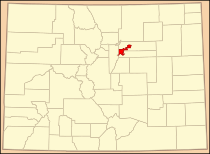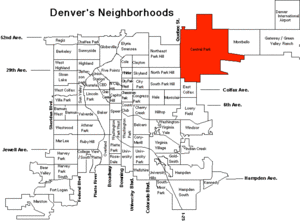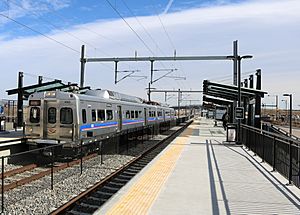Central Park, Denver facts for kids
Quick facts for kids
Central Park, Denver, Colorado
|
|
|---|---|
|
Neighborhoods in Denver
|
|

Location in the state of Colorado
|
|

Location within the County/City of Denver, Colorado
|
|
| Country | United States |
| State | Colorado |
| County | Denver |
| Founded by | Mayor Wellington Webb |
| Elevation | 5,312 ft (1,619 m) |
| Time zone | UTC–7 (MST) |
| • Summer (DST) | UTC–6 (MDT) |
| ZIP code |
80238, 80010
|
| Area code(s) | 303, 720 |
Central Park, once known as Stapleton, is a large and lively neighborhood in Denver. It is located east of downtown Denver. This area used to be the Stapleton International Airport, which closed in 1995. Central Park is the biggest neighborhood in Denver.
The neighborhood has many cool features. It includes twelve smaller areas, 11 public and private schools, and 50 parks. There are also 7 pools, many shopping and business areas, a Denver recreation center, and a Denver library. As of 2022, about 30,000 people live here.
Since 2016, Central Park has been connected to the wider Denver area by RTD's A Line. This is a commuter rail service that runs from downtown Denver to Denver International Airport.
Homes in Central Park come in many different styles, from very modern to traditional. Most single-family homes have garages at the back, facing an alley. You can find all kinds of housing here, like single-family houses, condos, townhomes, row homes, duplexes, and apartments.
The 80238 zip code covers most of Central Park. It is known as one of the wealthiest areas in Denver. In 2020, the community voted to change its name from Stapleton to Central Park.
Contents
History of Central Park
When the Denver International Airport was being built, people started thinking about what to do with the old Stapleton International Airport site. In 1990, a group of Denver leaders created a plan for the area. Their idea was to make a neighborhood where people could easily walk around, instead of needing a car for everything. They planned for almost a third of the airport site to become public parks.
The vision for the community was to have about 30,000 residents and 12,000 homes. It would also include an 80-acre Denver park called "Central Park." This park later inspired the neighborhood's new name. The plan also included a commuter-rail station, 14 schools, and lots of space for offices and shops. The neighborhood's open spaces also connect to the Sand Creek Regional Greenway and Bluff Lake Nature Center. This nature center is one of the largest urban wildlife refuges in the country.
The old airport site was very large, about 4,700 acres. It was only a 10-minute drive to Downtown Denver. The area was redeveloped by Forest City Enterprises and Brookfield Asset Management. They aimed to create a "new urbanist" community. This means designing a place that is walkable, has mixed-use buildings (shops and homes together), and public spaces.
Construction started in 2001, when Wellington Webb was the Mayor of Denver. The new community was planned for both homes and businesses. This included office parks, buildings with both homes and shops, and large shopping centers.
Central Park is the biggest neighborhood in Denver. A small part of the redevelopment area is actually in the nearby city of Aurora. This includes the Bluff Lake area.
Growth and Development
In 2004, the first residents moved into apartments in the neighborhood. This brought the population up to 2,500 people. By 2006, the community had grown to over 5,000 residents. That year, the Denver School of Science and Technology opened, along with The Shops at Northfield.
In 2007, the 80-acre 'Central Park' opened. This park later gave the neighborhood its new name. Also, three new office buildings were added, and the population grew to more than 7,500 people. By 2008, 3,200 homes, including single-family houses, row houses, and condos, had been built.
By 2011, over 14,000 people lived in the neighborhood. The network of trails for walking and biking reached 38 miles. The former Stapleton development project was even featured as the site of the 2011 HGTV Green Home. New highway exits also opened, connecting Central Park Boulevard to I-70 and I-270.
In 2016, the RTD A-Line began running. It directly connects Denver's Union Station in Downtown Denver, through Central Park, to Denver International Airport. The Central Park station is the only train stop in the community.
By 2019, the Central Park RTD Station area had grown even more. It now includes upscale apartments, offices, a new hotel, and shops. There are still some empty lots in this area ready for more development.
As of 2022, the Central Park neighborhood has an estimated population of 30,000. New homes are still being completed, with most expected to be finished by 2025. Because Central Park is so large, it can be hard to compare its crime rates or other statistics to smaller neighborhoods. Its big size and many busy areas (like the Northfield mall and I-70) mean it has more activity than many other neighborhoods.
Sub-neighborhoods
Central Park is made up of twelve smaller, named areas. These include North End Neighborhood, Central Park North, Beeler Park, Bluff Lake, Conservatory Green, Central Park West, East 29th Avenue, Eastbridge, South End, Westerly Creek, Wicker Park, and Willow Park East.
Transportation
Central Park has its own commuter rail and bus station. From here, you can take the A Line directly to Union Station in downtown Denver or to the Denver International Airport. The A Line trains can go fast, but they usually don't reach their top speed.
Central Park also has easy access to the I-70 highway, which runs east and west, and the I-270 interchange. The Denver metro's RTD bus system also serves Central Park with lines going in all directions. There are also many dedicated bike lanes and paths for cycling.
Name Change
The original airport was named after Benjamin F. Stapleton. He was the Mayor of Denver for several terms between 1923 and 1947. He was also a member of the Ku Klux Klan, a group known for its harmful and racist beliefs. While his membership was partly for political reasons, he later took steps to distance himself from the group. For example, in 1925, he fired the police chief who was connected to the Klan and welcomed the NAACP convention.
There were attempts to rename the Stapleton neighborhood in 2015 and 2019, but they did not succeed.
On August 1, 2020, after many discussions and votes, the residents chose "Central Park" as the new name for the neighborhood. About 63% of the voters picked this name over "Skyview," which was the other choice. The new name was inspired by the 80-acre "Central Park" within the neighborhood. The main road, Central Park Boulevard, and the RTD train station and recreation center were already named "Central Park" before the neighborhood's name change.
See also
- List of neighborhoods in Denver



